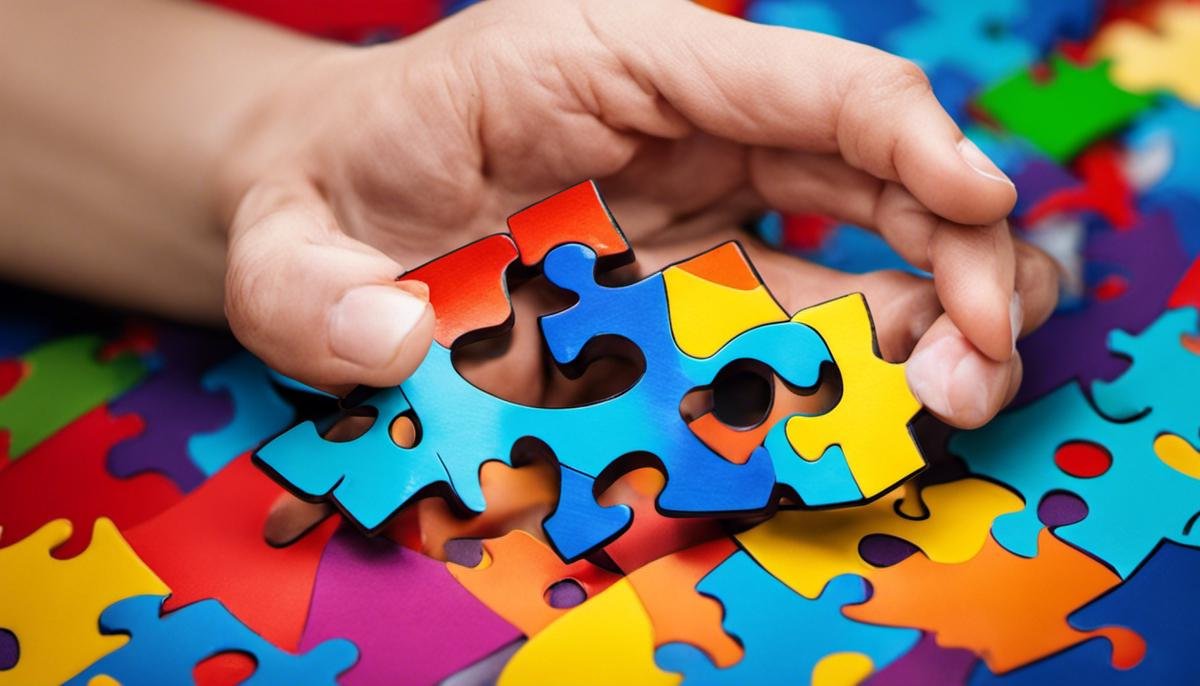
At the heart of the growing conversation on neurodiversity is a condition termed Autism Spectrum Disorder (ASD), an intricate and varied condition. Autism is characterized by a range of experiences, symptoms, and realities, wrapped under one umbrella. At instances mild, others profound, this condition impacts both children, adults, and their families alike, as they embark on an uncharted course of social, emotional, and cognitive development. It is imperative to gain a comprehensive understanding of Autism—its detection, diagnosis, behavioral therapies, school-based therapies, and medication—to construct an inclusive environment that cherishes uniqueness. This information not only enriches our understanding, but also paves the way for understanding the important role families play as pillars of support and advocates for change.
Understanding Autism
Understanding Autism: Impact on the Child and the Family
In the wonderful, diverse world of children, we discover myriad personalities, interests, and abilities. Some children, however, may face unique challenges in their journey. An important part of raising a child is understanding their specific needs and creating an environment of acceptance and support. Often, children diagnosed with autism spectrum disorder (ASD) need a little bit extra from the people around them. So, let’s delve deeper and unravel the profound concept of autism and its impact on the child and the family.
Autism or ASD is a neurodevelopmental disorder that affects a child’s behavior and their ability to interact and communicate with others. It manifests in varied ways and degrees, hence the term ‘spectrum’. The signs of autism often become apparent within the first three years of a child’s life. Some common manifestations include difficulties in social interaction, verbal and non-verbal communication, repetitive behaviors, and unique interests.
From the moment a child receives an autism diagnosis, adjustments are made that affect both the child’s life and the entire family. The impact is immeasurable and differs from person to person.
For the child, there can be a struggle with understanding facial cues, interpreting emotions, or responding to names. They might have a keen interest in specific subjects or favor following a certain routine. Variations in the sensory environment might affect them more acutely than others, leading to the repetitive behavior often associated with autism. Yet amidst these challenges, individuals with autism have been known to demonstrate exceptional abilities in focused areas, like music, math, or art, showing us all the wealth of potential within them.
As a family unit, living with autism might mean frequent therapy sessions, additional responsibilities, understanding the child’s unique needs, and constant learning. It demands patience, flexibility, and unconditional love. The journey won’t always be sunshine and rainbows; rough patches are sure to plot the path. Nevertheless, families often speak of learning to value the simple pleasures of life, gaining strength and resilience, understanding unique perspectives, and, above all, unconditional love.
One crucial piece of advice for families is to remember – you’re not alone. There is an entire community out there of parents, caregivers, and professionals who understand autism and are eager to lend a helping hand. Building connections with other families who are navigating the waters of autism can be helpful and comforting. They can shed light on valuable resources, therapeutic options, educational choices, and coping mechanisms.
Living with autism may be a challenge, but it’s far from a tragedy. It’s about learning to see the world from a unique perspective and appreciating the immense beauty that lies therein. Every child is a bundle of potential waiting to be discovered, and their difference from the norm doesn’t take away from their abilities or their value.
In the end, autism is a part of the child, not the entirety. Children with autism can lead fulfilling lives; they just need understanding, acceptance, and the space to grow. As a family, it’s about embarking on a journey of discovery and growth, towards a world where everyone accepts and supports each other’s unique ways.

Early Detection and Diagnosis of Autism
Guide to Early detection of Autism: The Importance and Diagnostic Steps
Discovering that a child has autism can often be a challenging experience for many parents. However, understanding the importance of its early detection cannot be overstated. If autism is identified at the earliest, it can furnish significant benefits, including improving the child’s social skills, reducing anxiety and depression, and enhancing the overall quality of life.
So, why is early detection of autism so crucial? Studies suggest that early intervention can make a substantial difference to a child’s development. The brain is most adaptable in the early years, which makes it the most suitable time to learn new skills and behaviors. For children on the autism spectrum, this could translate into improved communication abilities, better coping strategies, and a more independent lifestyle in the long run.
Early detection of autism fosters an environment that allows children to thrive. This timely detection can empower parents and caregivers with the tools they need to encourage the child’s development adequately, reducing the intensity of the disorder’s symptoms over time. In effect, the earlier the intervention begins, the better chances the child has for a fuller, more normalized life.
What then, are some of the methods through which autism can be diagnosed? Fortunately, there are several scientifically-backeded procedures that healthcare professionals use to diagnose autism, primarily observation and interacting with the child.
One common approach is the Modified Checklist for Autism in Toddlers (M-CHAT), utilized for children aged 16 to 30 months. Here, parents answer a set of questions about their child’s behavior. Based on the responses, the healthcare provider can then determine if the child is exhibiting signs consistent with autism.
Another assessment tool is the Autism Diagnostic Observation Schedule (ADOS). It involves a series of structured and semi-structured tasks that assess social interaction, communication, and play behaviors typical in young children.
Moreover, the Childhood Autism Rating Scale (CARS) rates the child on a scale from one to four in various areas such as relating to people, using body and object use, and listening response. A higher score indicates a higher likelihood of autism.
However, it is crucial to note that these assessment tools are not foolproof and only provide initial screening. A conclusive diagnosis would require a comprehensive evaluation by a team of specialists including psychologists, pediatric neurologists, and speech and language pathologists.
While receiving an autism diagnosis can be challenging, remember, it is not a dead-end. Early detection can be a passage to timely intervention, endless possibilities, and a life of vitality for your child.
In this journey, let’s not forget, acknowledging the uniqueness of individuals with autism is what truly catalyzes their growth. They are not broken; they are special, with extraordinary capabilities. So, let’s celebrate their differences while ensuring they lead a full, happy, and productive life.

Behavioral Therapies
Shifting the spotlight further into the lives of individuals living with autism, let’s thoughtfully delve into the sphere of behavioral therapies. For those who are not quite familiar with this term – behavioral therapy is a broad term that refers to treatments designed to change certain undesirable behaviors. What’s truly delightful about this approach is that it encourages positive behavior while discouraging negative behavior – a genuinely helpful approach when dealing with autism.
Now, let’s explore a few types of these behavioral therapies that have proven beneficial for children with autism.
- Applied Behavior Analysis (ABA): For parents seeking a scientific approach, ABA might be the one. It focuses on positive reinforcement and repeated practice to bring about a change in a child’s behavior, helping them build useful life skills while minimizing problematic behaviors. It’s customizable to each child’s unique needs which makes it a widely adopted approach.
- Cognitive Behavioral Therapy (CBT): If you’ve ever wished there were ways to help children with autism handle their emotions better, CBT might just be the answer. It helps children understand their feelings, thoughts, and behaviors, creating a framework for them to function and communicate effectively.
- Early Start Denver Model (ESDM): For little ones under the age of 5, ESDM combines elements of ABA with developmental and relationship-based approaches. This therapy focuses on building positive relationships through play and joint activities.
- Pivotal Response Treatment (PRT): Slightly different than the rest, PRT targets critical, or “pivotal,” behaviors that affect a wide range of areas. It encourages children to monitor their behavior, initiate communication with others, and respond to multiple cues enhancing their social skills.
Look at behavioral therapy as a toolbox of strategies that cater to your child’s unique strengths and challenges, with a potent ability to make a profound difference.
Families, however, should remember that it’s not a one-size-fits-all solution. Each child is beautifully unique, and what works miracles for one might not have the same effect on another.
Also, it’s crucial to understand that these therapies require consistent efforts, patience, and persistence over an extended period. The results may be slow, but remember, every small step towards progress matters and should be cherished.
It’s uplifting to note that we live in an era where resources, therapies, and community support for autism are becoming increasingly available and sophisticated. Together, through collective understanding, patience, and efforts, we can contribute to creating an environment where children with autism can thrive.
Seeking professional advice and getting the right therapy for your child can open a window of endless opportunities for them. Let’s embrace this journey with faith and optimism and remember – we’re in this together. In the world of autism – love, acceptance, and understanding makes the world go round.
Finally, here are a few reminders that are worth keeping at the forefront: Keep experimenting with different therapies until you find one that best suits your child’s needs. Don’t lose hope if progress seems slow, remember; patience is a virtue. Moreover, celebrate every tiny victory, because in our world, every milestone – small or large, is a ray of sunshine lighting up our way forward. Let’s remember, not just today, but every single day, that autism doesn’t define our children. They are so much more. Let’s celebrate their individuality, cherish their uniqueness, and revel in their beautiful journey of growth and development.

Educational and School-based Therapies
The Essence of Educational Interventions in Autism Management
As we delve deeper into the world of autism and its many diverse realities, it’s important to note the role that targeted educational interventions play in managing this condition. Remember our previous discussions regarding early detection and the significance of a comprehensive evaluation by a team of professional experts? The importance of educational interventions emerges from these very pivotal aspects that factor into an Autism Spectrum Disorder (ASD) diagnosis.
Following diagnosis, families often find themselves seeking the best possible ways to support their child. This is where educational interventions come into play, acting as a guiding light in the often overwhelming landscape of autism. These interventions, tailored to each child’s unique needs, provide a structured and supportive learning environment that fosters growth and development.
Let’s begin by discussing behavioral therapy, a major stride forward in the realm of autism management. Focused on changing undesirable behaviors, it aids in creating a positive and supportive environment conducive to growth.
Born out of the principles of behavioral therapy is Applied Behavior Analysis (ABA). ABA is a versatile and comprehensive intervention designed to assist children with autism in improving their social, communication, and learning skills through positive reinforcement.
Cognitive Behavioral Therapy (CBT), another educational intervention, works wonders in managing anxiety and emotions, thereby reducing the impact of autism on a child’s life. By focusing on developing personal coping strategies, CBT helps children understand and control their feelings and emotions.
Another definitive approach is the Early Start Denver Model (ESDM). This intervention integrates the teachings of ABA with developmental and relationship-based approaches, particularly for toddlers and preschool-aged children. Through play and joint activities, ESDM promotes positive relationships, emotional growth, and communication skills.
Moving along, let’s not overlook Pivotal Response Treatment (PRT), which focuses on pivotal areas of a child’s development without directing them into scripted responses. Rather, natural reinforcement gets used to improve children’s motivation and responsiveness.
You might be asking, “Are all these approaches equally effective?” Good question! An essential reality of autism management is the variability in effectiveness for each child. Remember, each child’s journey with autism is unique, making individual treatment approaches important.
Every intervention requires consistent efforts, patience, and persistence for their full impact to be appreciated. Sometimes, results may not be instantaneous, but every little step forward is a victory worth celebrating!
In many communities, numerous resources, therapies, and supports are readily available for children with autism and their families. Seeking professional advice can go a long way in finding suitable interventions and therapies.
Never forget that this journey can be a challenging one. It’s okay to try different therapies and interventions until you find the right answer. Patience, love, and understanding are your greatest allies. Celebrate each progress made, no matter how small it seems.
Whether you’re starting your autism journey or are well into it, infuse every step you take with faith and optimism. Remember, each child with autism is unique in their abilities and growth spurts. The journey of autism, despite its challenges, can undoubtedly be one of the most rewarding endeavors one can undertake.
In the world of autism, acceptance and understanding bear incredible significance. An ASD diagnosis is not a dead-end, rather the beginning of a life that will be filled with triumph in the face of adversity and immeasurable growth. This journey is one to embrace, learn from, and above all, celebrate.

Family Support and Training
Families Navigate Autism Trainings and Tools for Success
Living with a child on the autism spectrum can be a transformative journey for a family. It might start with learning about the autism spectrum, to the subtle signs of autism, and then onto the monumental shift in family life. As the journey continues, it becomes about exploring the unique gifts that children with autism offer and creating a loving, supportive environment for them to grow. Alongside, there is a celebration of the uniqueness of an individual with autism. All that being established, a critical component of this journey often involves understanding the available training and interventions that may significantly enhance their life quality and create loving, supportive families.
For families embarking on this autism journey, a powerful ally can be various training programs. These courses aim to equip parents, siblings, and extended family members with the necessary skills and understanding to support their child with autism effectively. Training includes understanding behavioral patterns, communication challenges, optimizing home and school environments, and accessing supports and resources within the community.
One such resource could be the Training of Parents of Children with Autism to use the Picture Exchange Communication System (PECS). This program allows communication training at home, relying on exchanging pictures of needed or desired items, creating a bridge between the child and the family. Simultaneously, AFIRM (Autism Focused Intervention Resources & Modules) offers free online training modules on various evidence-based strategies designed specifically for children with autism.
Turning today’s prominence in the digital age into a boon, there are plenty of online training courses specifically tailored for families. These include platforms like Autism Parents Training, which offers courses like “Autism 101” – a starter kit for families just starting their autism journey. For families who have been on this path for a bit longer, there are more specialized courses, such as “School Success,” focusing on navigating the special education system, or “Life Skills,” which imparts strategies for teaching daily living activities.
Also, a treasure trove of resources can be found in the Autism Internet Modules (AIM) platform. With over 40 free modules, AIM explores a wide range of topics, from “The Power of the Parent” to “Visual Supports,” and even dives into particularly complicated areas, such as “Understanding and Addressing Challenging Behavior.”
Rounding these off, let’s not forget local resources. Local autism societies, local parent-led support groups, occupational therapy clinics that work with children on the spectrum often provide parent training opportunities. Also of note are Parent Child Interaction Training (PCIT) and Hanen programs, widely saluted for their effectiveness.
It’s important to remember that there is not a single foolproof formula for supporting a child with autism. Each training or intervention may yield different results, depending on the child’s unique characteristics, and that’s perfectly alright. What might not work today may work tomorrow, or a week, a month, or even a year from now. Laced within this unpredictable journey are moments of triumph – first-time achievements, progress in behavioural therapies, or a leap under ABA.
What keeps this journey going is an undying persistence and patience. Patience with therapies, patience with progress, and above all, patience with oneself. In this world of autism, every tiny step forward is a victory worth celebrating.
Both resources and training give families hope, tools, and strategies to enhance their child’s development and family harmony. They impart a real sense of power and control in sometimes challenging circumstances. There’s no denying that living with autism involves unique challenges, but there’s also no denying the immense strength and resilience found within these families.
And at the end of the day, the essence of it all is love, acceptance, and understanding. Embrace this journey with faith and optimism. After all, in this ride called life, it’s not just about arriving at the destination but also growing and learning through the journey.
In the world of autism, every individual is unique. Let’s celebrate this uniqueness, growth, and the resilience of our wonderful children. They remind us, after all, that while things may not always go as planned, they can still go beautifully.

Medication and Other Therapies
After exploring the fundamentals of Autism Spectrum Disorder (ASD) and understanding therapies like ABA (Applied Behavior Analysis), CBT (Cognitive Behavioral Therapy), ESDM (Early Start Denver Model) and PRT (Pivotal Response Treatment), let’s discuss the role of medication in autism treatment.
While there is no cure for autism, certain medications can help manage high-energy, aggressive, or self-harmful behaviors often seen in individuals with the condition. However, it’s important to remember that these medicines don’t treat the autism itself – they only address the related symptoms. Medications including antipsychotics such as Risperidone and Aripiprazole hold FDA approval specifically to treat irritability linked with autism in children. Selective serotonin reuptake inhibitors (SSRIs), antianxiety medicines, and stimulants can similarly alleviate symptoms.
A pediatrician, psychiatrist, or developmental pediatric specialist is typically tasked with prescribing medications to children with autism. The experts vigilantly monitor the child’s progress, observing for side-effects and adjusting dosages as necessary. It’s vital to view medication as part of an integrated treatment plan that includes behavioral therapies and educational strategies.
In addition to medication and behavioral therapies, numerous other interventions are beneficial for people with ASD. Cognitive training, occupational therapy, speech therapy, and assistive technology are a few examples. Cognitive training exercises the brain – much like physical therapy strengthens the body. It can improve cognitive abilities such as working memory, attention, auditory and visual processing, and logic & reasoning.
Occupational and speech therapies revolve around improving everyday functional abilities and communication skills. An occupational therapist addresses fine motor skills, teaching actions like buttoning a shirt. They also address gross motor skills, helping children participate fully in school routines and social events. Speech therapists work on communication skills, teaching verbal or non-verbal methods such as sign language or using a communication device.
Furthermore, visual supports can work wonders for children with ASD, who often are visual learners. These can be as simple as written lists and charts or as high-tech as tablets loaded with a specially designed communication app. Assistive technology and apps can also be of huge benefit for children who struggle with motor skills.
Even amidst the trials, walking side-by-side with your child in this journey of autism can be a profound experience. When your child showcases a unique skill, experiences progress, even if minuscule in behavioral therapy, or successfully communicates a need for the first time, they are moments to rejoice.
Remember, facing autism entails embracing and riding the waves of trials and triumphs, setbacks and strides. Acceptance, patience, persistence, love, and resilience should be the guiding stars of this voyage. Reach out to professionals who are ready to help, educate yourself with available resources, embrace the social support structures available, and trust in the journey. Taking one day at a time, armed with knowledge, understanding, and acceptance, contributes towards creating a love-filled environment for your beloved child to thrive.

Treating autism is not just about managing symptoms or making a child fit into societal norms, it encapsulates a larger goal of fostering a nurturing environment that respects neuro-diversity and recognizes the strengths of individuals with autism. As we explore early interventions, education strategies, and medication options, it becomes clear that a multi-faceted approach is key when it comes to Autism treatment. Our collective awareness and understanding of the impact of the disorder, the ways it can be detected early, and the therapeutic models that drive positive change are stepping stones towards a more empathetic and inclusive society. It reinforces that, with the right support, every child on the autism spectrum has the potential to make their unique contribution to the world.




